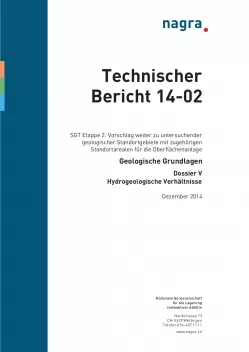
Technischer Bericht NTB 14-02/V
SGT Etappe 2: Vorschlag weiter zu untersuchender geologischer Standortgebiete mit zugehörigen Standortarealen für die OberflächenanlageGeologische GrundlagenDossier V:Hydrogeologische Verhältnisse
Dossier V: Hydrogeological conditions
The Dossier on hydrogeological conditions analyses the hydrogeological conditions on a regional and local scale. The focus is on the conditions in the deep aquifers which, for deep geological repositories, represent potential flowpaths for radionuclides from the outer boundary of the effective containment zone into the biosphere. The characterisation of the deep aquifers also makes an important contribution to understanding the situation in the host rocks, for example with regard to porewater salinity. Knowledge of the hydrogeological conditions in deep aquifers is also important for constructing the accesses to the deep repository, for example for evaluating the potential influence on the use of mineral and thermal waters or for the planning of deep groundwater management. In this sense, the Dossier on hydrogeological conditions has connections to Dossier VI on the barrier properties of the host rocks and confining units and Dossier VII on conflicts of use. For the criteria and indicators used in the safety-based comparison of the siting regions, the Dossier provides the basic information used to evaluate the indicator 'groundwater storeys' as well as supplementary information on the criteria 'geochemical conditions’, 'conflicts of use', 'predictability of long-term changes' and 'underground development infrastructure and water management'.
The Dossier is based on information from earlier work and integrates new publications and reports of third parties. As part of Stage 2 of the Sectoral Plan process, the level of knowledge of hydrogeological conditions was improved through observations in several boreholes, analyses of field observations, literature studies and data compilations. The datasets for hydrochemistry and isotope hydrogeology of the deep groundwaters of Northern Switzerland were expanded and the regional situation was re-evaluated in detail. Hydrodynamic models were developed on a regional and local scale for analysing the hydrogeological conditions in Northern Switzerland. These stationary models were used to test a range of scenarios, for example regarding the hydraulic properties of individual units or faults, and to analyse the impacts, for example, on the hydraulic gradients across the host rocks or the exfiltration zones. This allows a spectrum of potential hydrogeological situations to be identified and to constrain the input data required for the safety analyses. Comprehensive analyses of the hydrogeological situation from earlier work were already available for the Wellenberg siting region.
The Malm and Muschelkalk aquifers in Northern Switzerland form the regional deep aquifers above and below the host rocks and thus define the maximum extent of the potentially effective containment rock zone. In western areas, the Hauptrogenstein aquifer also has to be considered; this forms the upper boundary of the confining units of the Opalinus Clay in the siting regions Jura Ost and Jura-Südfuss. In the latter region, and possibly together with the Birmenstorf Member, it forms the aquifer directly below the Effingen Member. Other units may be relevant as exfiltration pathways on a local scale; in the Upper Mittelkeuper in particular, some layers can exhibit aquifer characteristics (Keuper aquifer), depending on their lithological composition. Regional fault zones can also influence the regional hydrogeological conditions. The significance of these zones for flow systems, exfiltration locations and gradients across the host rocks was investigated in the context of scenario analyses.
In the chapter on the regional hydrochemistry of Northern Switzerland, the first step is to present the general chemical and isotope hydrogeology characteristics for each hydrogeological unit, as well as the evolution of the deep groundwaters. This then forms the basis for discussion of flow systems from a hydrochemical perspective. In areas not or only slightly affected by tectonics, the groundwater shows aquifer specific hydrochemical characteristics (groundwater storeys) that underpin the efficient separation effect of the aquitards, for example in the Dogger (Opalinus Clay, 'Brauner Dogger'), Lias and Gipskeuper. In areas more strongly affected by tectonics, connections that partly extend beyond single formations can be observed, for example the well known thermal water springs of Baden/Ennetbaden and Schinznach Bad located on the Jura Main Thrust.
In the chapter on the site-specific hydrogeology of Northern Switzerland, the general hydrogeological situation is characterised for each siting region and hydrogeologically relevant observations (for example in boreholes, outcrops or underground structures) are summarised. Of particular interest here are observations of the local lithology of the confining units and associated hydrogeological observations, for example in the Sissach Member of the Passwang Formation or sandy-limestone-rich intercalations in the Lias. The main exfiltration areas are listed for each region based on the modelling studies. The hydraulic gradients across the host rocks are defined based on scenario analyses using the local models, taking into account any available local measurements of hydraulic potential.
Thanks to the numerous boreholes and field investigations, an extensive hydrogeological database exists for the Wellenberg siting region. This has already been analysed in detail and integrated into hydrodynamic models on different scales. These also include different conceptual approaches for the hydraulic properties of the host rock. One particular feature is the underpressure zone encountered in the Helvetic Marls. This is a transient phenomenon associated with mechanical unloading due to erosion and/or glacier retreat. The exfiltration pathways are evaluated taking into account the reduction of this underpressure zone on the long term. The significance of the geological profiles that were reworked for Stage 2 and the deeper disposal level (compared to earlier planning) are also discussed.
A marked zoning of the types of deep groundwaters was observed in the deep boreholes at Wellenberg; this includes characteristic isotope signatures and residence times. According to the most recent plans, the disposal zones would be located at levels where neoalpine formation water is expected. High methane contents were also encountered in some of the deep groundwaters – available data indicate that this is dissolved gas, but free gas also has to be expected in some zones.
